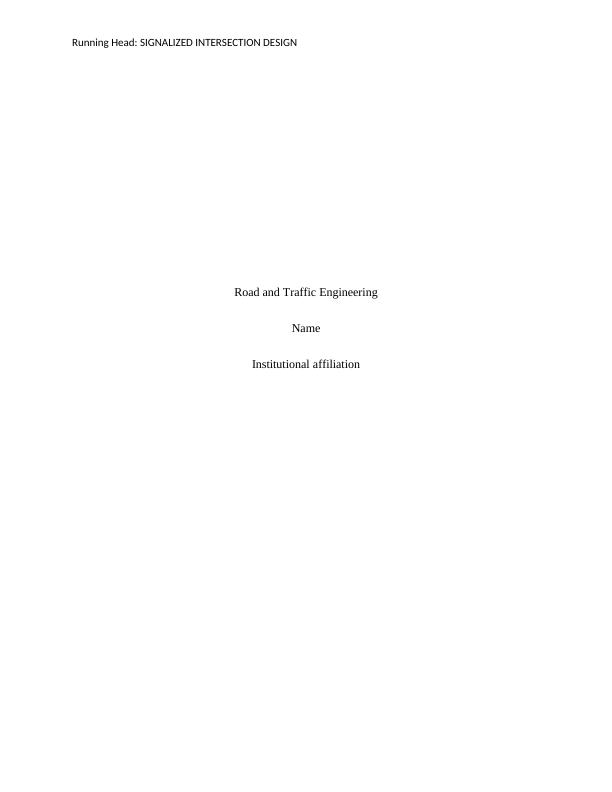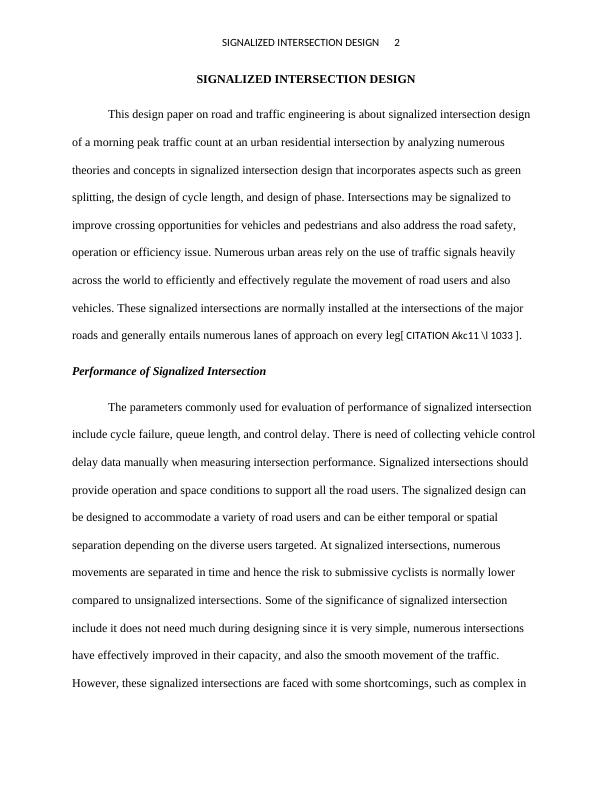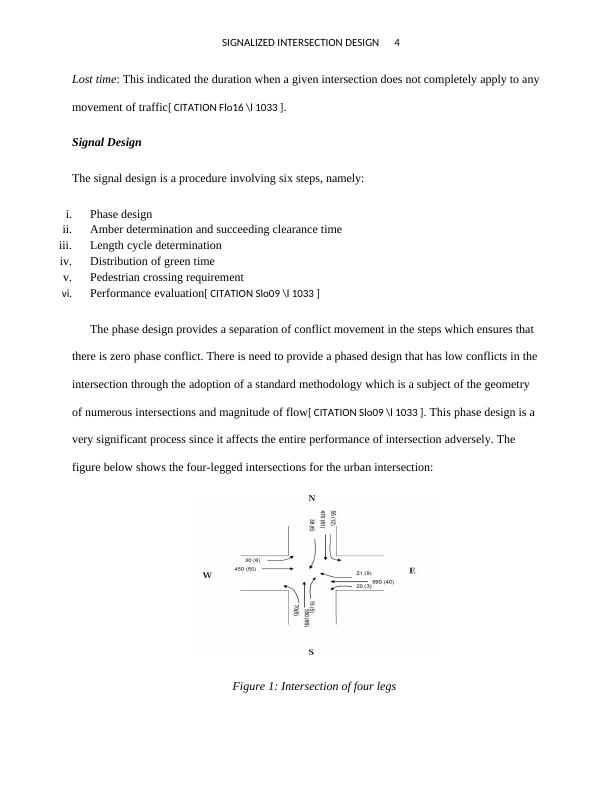Ask a question from expert
Signalized intersection design Assignment PDF
16 Pages2729 Words214 Views
Added on 2021-06-17
Signalized intersection design Assignment PDF
Added on 2021-06-17
BookmarkShareRelated Documents
Running Head: SIGNALIZED INTERSECTION DESIGNRoad and Traffic EngineeringNameInstitutional affiliation

SIGNALIZED INTERSECTION DESIGN 2SIGNALIZED INTERSECTION DESIGNThis design paper on road and traffic engineering is about signalized intersection design of a morning peak traffic count at an urban residential intersection by analyzing numerous theories and concepts in signalized intersection design that incorporates aspects such as green splitting, the design of cycle length, and design of phase. Intersections may be signalized to improve crossing opportunities for vehicles and pedestrians and also address the road safety, operation or efficiency issue. Numerous urban areas rely on the use of traffic signals heavily across the world to efficiently and effectively regulate the movement of road users and also vehicles. These signalized intersections are normally installed at the intersections of the major roads and generally entails numerous lanes of approach on every leg[ CITATION Akc11 \l 1033 ]. Performance of Signalized IntersectionThe parameters commonly used for evaluation of performance of signalized intersection include cycle failure, queue length, and control delay. There is need of collecting vehicle control delay data manually when measuring intersection performance. Signalized intersections should provide operation and space conditions to support all the road users. The signalized design can be designed to accommodate a variety of road users and can be either temporal or spatial separation depending on the diverse users targeted. At signalized intersections, numerous movements are separated in time and hence the risk to submissive cyclists is normally lower compared to unsignalized intersections. Some of the significance of signalized intersection include it does not need much during designing since it is very simple, numerous intersections have effectively improved in their capacity, and also the smooth movement of the traffic. However, these signalized intersections are faced with some shortcomings, such as complex in

SIGNALIZED INTERSECTION DESIGN 3its implementation and design, and also delays caused by stoppage durations[ CITATION Aus13 \l 1033 ]. Design ConceptsThe following are some of the signal intersection concepts and definitions which are used in the signalized intersection design interpretation:Cycle: This is the complete cycle of all the traffic through the used indication pointsRed Interval: This is the time taken for the signal at the intersection to show red signal during a given movementCycle length: This is the time taken for green light to reappear again and it is measured in second. It is denoted by C. Interval: This is the signal alternation from one stage of the signal to another. There are two different types of interval domain, namely, clearance interlude and change interlude. Go-ahead duration is also known as all red and is the time when the traffic signal indicates all red, basicallyused to clear vehicle in a particular intersection side. Change duration is also known as the time of the yellow signal and it indicates the time between green and red traffic signals during a singleapproach.[ CITATION Mic11 \l 1033 ]Green interval: This is the time when it indicates a go for a given intersection section normally denoted by Gi. It is the actual duration when the lights change to green. Red interval: This is the time when the signal of intersection indicates red at a given movement. Phase: It is the summation of the following change plus clearance and green interval.

SIGNALIZED INTERSECTION DESIGN 4Lost time: This indicated the duration when a given intersection does not completely apply to anymovement of traffic[ CITATION Flo16 \l 1033 ]. Signal DesignThe signal design is a procedure involving six steps, namely:i.Phase designii.Amber determination and succeeding clearance timeiii.Length cycle determinationiv.Distribution of green timev.Pedestrian crossing requirementvi.Performance evaluation[ CITATION Slo09 \l 1033 ]The phase design provides a separation of conflict movement in the steps which ensures that there is zero phase conflict. There is need to provide a phased design that has low conflicts in theintersection through the adoption of a standard methodology which is a subject of the geometry of numerous intersections and magnitude of flow[ CITATION Slo09 \l 1033 ]. This phase design is a very significant process since it affects the entire performance of intersection adversely. The figure below shows the four-legged intersections for the urban intersection:Figure 1: Intersection of four legs

End of preview
Want to access all the pages? Upload your documents or become a member.
Related Documents
Signalized Intersection Design - PDFlg...
|16
|2729
|92
Road and Traffic Engineeringlg...
|16
|3253
|88
Transportation Engineering: Traffic Signal Designlg...
|14
|2384
|311
Traffic Intersection: Overview, Control Levels, Types, and State Machinelg...
|4
|717
|136
Modelling and Analysis of Traffic Light Control Systems - Paper Reviewlg...
|14
|4678
|58